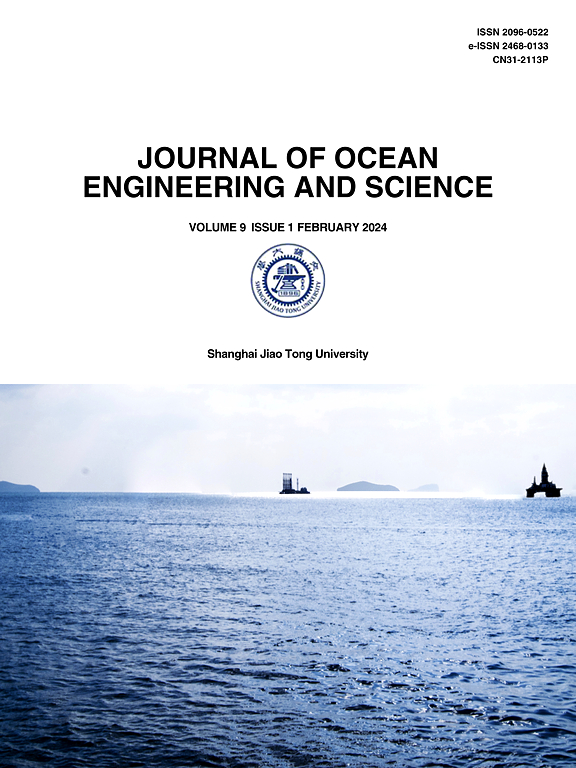圆柱二自由度涡激振动的二维和三维数值模拟:比较研究
IF 11.8
1区 工程技术
Q1 ENGINEERING, MARINE
引用次数: 0
摘要
寻找一种可靠、高效的数值计算方法对于海上隔水管的安全设计具有重要意义,该隔水管的模型可以简化为弹性安装圆柱的涡激振动。本文采用二维和三维方法,对质量比m*=2.6、质量阻尼参数(m*+1)ζ=0.013的两自由度圆柱的涡激振动响应进行了数值研究。在亚临界雷诺数(Re范围为1×103 ~ 1.5×104)下,采用非定常雷诺平均纳维-斯托克斯(URANS)和剪切应力输运(SST) k−ω湍流模型进行了模拟。从整体结果来看,二维和三维仿真都可以获得相对准确的统计结果,包括VIV响应幅值和频率值。二维模拟与三维模拟的主要区别在于超上支存在的三维效应和流动过渡条件。而二维数值模拟与三维模拟相比,可以节省数百倍的计算资源,因此更适合于这种条件下的工程涡激振动预测。通过仿真与实验结果的对比,为海上立管2-DOF涡激振动的研究与工程选择合适的二维或三维仿真方法提供了研究支持。本文章由计算机程序翻译,如有差异,请以英文原文为准。
Numerical simulations of 2-DOF vortex-induced vibration of a circular cylinder in two and three dimensions: A comparison study
Finding a reliable and efficient numerical method is of great importance for the safety design of a offshore riser whose model can be simplified as vortex-induced vibration (VIV) of an elastically-mounted circular cylinder. In the current study, two-degree-of-freedom (2-DOF) VIV responses of a circular cylinder with a small mass ratio and small mass damping parameter is numerically investigated by two- and three-dimensional method. The simulations by using the URANS (Unsteady Reynolds Averaged Navier-Stokes) in combination with the SST (Shear Stress Transport) turbulence model are performed at subcritical Reynolds numbers ( ranges from to ). From the overall results, both the 2D and 3D simulations can obtain relatively accurate statistical results including VIV response amplitudes and frequency values. The main differences between the 2D and 3D simulations lie on the three-dimensional effects that exist in the supper upper branch and the flow transition condition. However, the 2D numerical simulations can save hundreds of times of the computational resources compared with a 3D simulation, hence is more suitable for engineering VIV prediction under such conditions. The comparison of simulation and experimental results in this study provides research support for the selection of appropriate simulation methods (2D or 3D) for 2-DOF VIV of an offshore riser in research and engineering.
求助全文
通过发布文献求助,成功后即可免费获取论文全文。
去求助
来源期刊

Journal of Ocean Engineering and Science
Multiple-
CiteScore
11.50
自引率
19.70%
发文量
224
审稿时长
29 days
期刊介绍:
The Journal of Ocean Engineering and Science (JOES) serves as a platform for disseminating original research and advancements in the realm of ocean engineering and science.
JOES encourages the submission of papers covering various aspects of ocean engineering and science.
 求助内容:
求助内容: 应助结果提醒方式:
应助结果提醒方式:


